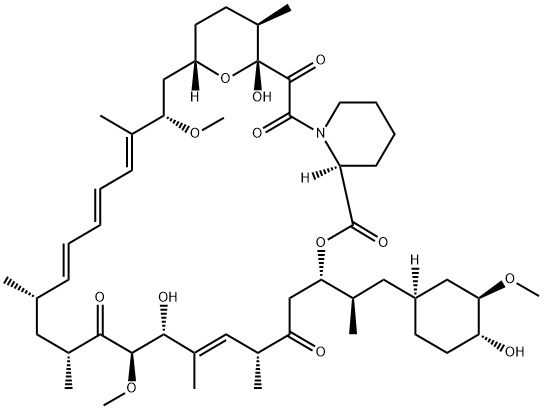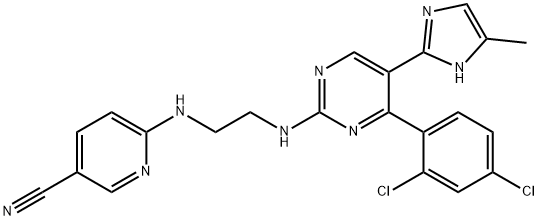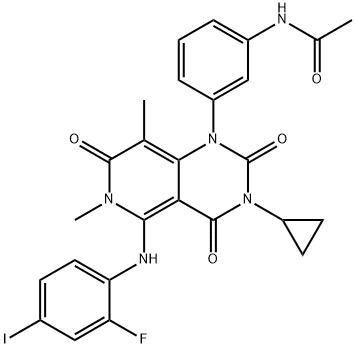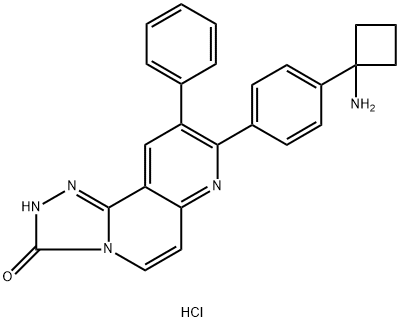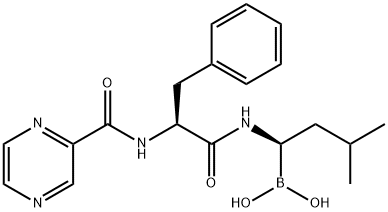42-(Dimethylphosphinate)rapamycin
- CAS NO.:572924-54-0
- Empirical Formula: C53H84NO14P
- Molecular Weight: 990.21
- SAFETY DATA SHEET (SDS)
- Update Date: 2023-05-18 11:31:20
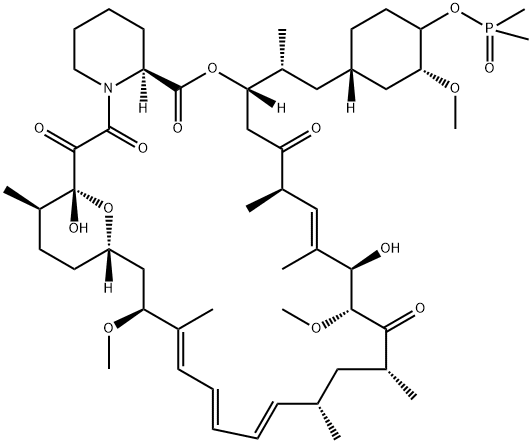
What is 42-(Dimethylphosphinate)rapamycin?
Description
MK-8669 is a rapamycin analog that selectively inhibits mTOR (IC50 = 0.2 nM). Like rapamycin, MK-8669 binds FKBP12 to form a complex that associates with the FKBP-rapamycin binding domain on mTOR and allosterically inhibits mTORC1 kinase activity. MK-8669 is more water soluble than rapamycin and is amenable to oral or intravenous administration. Formulations containing rapalogs, including MK-8669, have promise against a subset of cancers, including advanced kidney cancer. MK-8669 is also being examined for effectiveness against cancers when used in combination with other chemotherapeutic compounds.
Chemical properties
Off-White Solid
The Uses of 42-(Dimethylphosphinate)rapamycin
An immunosupressant and is currently being investigated for use in cancer treatments. Ridaforolimus may act as a regulator of protein synthesis, cell proliferation, cell cycle progression and cell survival. Ridaforolimus, was formerly known as Deforolimus.
The Uses of 42-(Dimethylphosphinate)rapamycin
Ridaforolimus is a semisynthetic macrocyclic lactone prepared from rapamycin by selective alkylation of the 42-hydroxy group with a dimethylphosphinate moiety. Like all tacrolimus analogues, ridaforolimus binds to receptor protein, FKBP12. The complex then binds to mTOR preventing its interaction with target proteins. Ridaforolimus is extensively cited in the literature with over 70 citations.
The Uses of 42-(Dimethylphosphinate)rapamycin
An immunosupressant and is currently being investigated for use in cancer treatments. Ridaforolimus may act as a regulator of protein synthesis, cell proliferation, cell cycle progression and cell survival. Ridaforolimus, was formerly known as Deforolimus. Potent mTORC1 inhibitor.
What are the applications of Application
Ridaforolimus is a selective mTOR (FRAP) inhibitor
Definition
ChEBI: A semisynthetic derivative that is sirolimus in which hydroxy group attached to the cyclohexyl moiety has been converted to the corresponding dimethylphosphinate.
in vivo
mice bearing mcf7 (breast), pc-3 (prostate), a549 (lung), hct-116 (colon) or panc-1 (pancreas) xenografts have revealed the antitumor efficacy of ridaforolimus [1].
References
[1] rivera vm1, squillace rm, miller d, berk l, wardwell sd, ning y, pollock r, narasimhan ni, iuliucci jd, wang f, clackson t.ridaforolimus (ap23573; mk-8669), a potent mtor inhibitor, has broad antitumor activity and can be optimally administered using intermittent dosing regimens. mol cancer ther. 2011 jun;10(6):1059-71.
Properties of 42-(Dimethylphosphinate)rapamycin
| Melting point: | 95-98°C |
| Boiling point: | 996.2±75.0 °C(Predicted) |
| Density | 1.18±0.1 g/cm3(Predicted) |
| storage temp. | Hygroscopic, -20°C Freezer, Under Inert Atmosphere |
| solubility | DMSO (Slightly), Methanol (Slightly) |
| form | Solid |
| pka | 10.40±0.70(Predicted) |
| color | Off-White to Pale Yellow |
| Stability: | Hygroscopic |
Safety information for 42-(Dimethylphosphinate)rapamycin
Computed Descriptors for 42-(Dimethylphosphinate)rapamycin
New Products
Tert-butyl bis(2-chloroethyl)carbamate 4-Methylphenylacetic acid N-Boc-D-alaninol N-BOC-D/L-ALANINOL N-octanoyl benzotriazole 3-Morpholino-1-(4-nitrophenyl)-5,6-dihydropyridin- 2(1H)-one Furan-2,5-Dicarboxylic Acid DIETHYL AMINOMALONATE HYDROCHLORIDE 1,1’-CARBONYLDIIMIDAZOLE R-2-BENZYLOXY PROPIONIC ACID 1,1’-CARBONYLDI (1,2-4 TRIAZOLE) N-METHYL INDAZOLE-3-CARBOXYLIC ACID (2-Hydroxyphenyl)acetonitrile 4-Bromopyrazole 5-BROMO-2CYANO PYRIDINE 5,6-Dimethoxyindanone 5-broMo-2-chloro-N-cyclopentylpyriMidin-4-aMine 2-(Cyanocyclohexyl)acetic acid 4-methoxy-3,5-dinitropyridine 1-(4-(aminomethyl)benzyl)urea hydrochloride 2-aminopropyl benzoate hydrochloride diethyl 2-(2-((tertbutoxycarbonyl)amino) ethyl)malonate tert-butyl 4- (ureidomethyl)benzylcarbamate Ethyl-2-chloro((4-methoxyphenyl)hydrazono)acetateRelated products of tetrahydrofuran
You may like
-
 Ridaforolimus CAS 572924-54-0View Details
Ridaforolimus CAS 572924-54-0View Details
572924-54-0 -
 1975-50-4 98%View Details
1975-50-4 98%View Details
1975-50-4 -
 2-HYDROXY BENZYL ALCOHOL 98%View Details
2-HYDROXY BENZYL ALCOHOL 98%View Details
90-01-7 -
 2-Chloro-1,3-Bis(Dimethylamino)Trimethinium Hexafluorophosphate 221615-75-4 98%View Details
2-Chloro-1,3-Bis(Dimethylamino)Trimethinium Hexafluorophosphate 221615-75-4 98%View Details
221615-75-4 -
 61397-56-6 CIS BROMO BENZOATE 98%View Details
61397-56-6 CIS BROMO BENZOATE 98%View Details
61397-56-6 -
 14714-50-2 (2-Hydroxyphenyl)acetonitrile 98+View Details
14714-50-2 (2-Hydroxyphenyl)acetonitrile 98+View Details
14714-50-2 -
 118753-70-1 98+View Details
118753-70-1 98+View Details
118753-70-1 -
 733039-20-8 5-broMo-2-chloro-N-cyclopentylpyriMidin-4-aMine 98+View Details
733039-20-8 5-broMo-2-chloro-N-cyclopentylpyriMidin-4-aMine 98+View Details
733039-20-8
